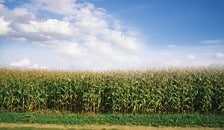Corn and beans, the keys to healthy markets

When Don Roose looks to China, he sees the United States of the 1940s and 1950s. He likes what he sees.
Roose is president of U.S. Commodities Inc. in West Des Moines. He tracks the prices of corn and soybeans and other agricultural products and he watches with a little amazement as those crops, soybeans in particular, are exported to China.
“Their economy and standard of living apparently jumped disproportionately to their ability to grow a crop,” Roose said. He noted that “rumor” has it that the nation is preparing to source more pork and beef.
Iowa ranks first in the nation for exports of soybeans, and it is second overall in shipping agricultural products to the world. The U.S. Department of Agriculture (USDA) said in December that the state accounted for nearly $6.5 billion in agriculture exports.
Estimates for Iowa agricultural exports in the market year that will end Aug. 31 were not available at press time, but Roose compiled his own numbers for U.S. exports, and they appear to be headed for continued growth, especially when considered as a percentage of the overall harvest.
Roose estimates that the nation’s farmers will ship 1.95 billion tons of corn and nearly 1.6 billion tons of soybeans to the world by August.
Corn will go primarily to Japan and Mexico, with little shipped to China.
He noted that although U.S. farmers produce more soybeans than any other country, they can’t compete with the combined output of Brazil and Argentina.
Roose advises his clients to buy land in those countries and grow and harvest crops there when the land lies fallow in North America.
“It gives you a chance to take advantage of those different cycles from a weather standpoint,” he said. “If you really look at it, it gives you a chance to spread out your risk a little bit.”
In addition, soybeans bought from South America won’t necessarily bite into the export market out of Iowa.
“China has not slowed down its purchasing,” Roose said.
Other developing nations will continue to clamor for U.S. agricultural exports.
“What’s happened is that our crop size has grown dramatically, and we’ve been able to do that with a few more acres, but really with genetics. At the same time, our demand has grown around the world. As we move into this information age, more people are exposed to the standards of living around the world, so countries like India and China try to scramble to meet their needs. Food demand continues to grow, the protein diet in particular,” Roose said.
Roose has been studying and brokering commodities markets since the 1970s, and he is not prone to reacting with alarm to trends in agriculture. Take the food for fuel debate, for example.
About 38 percent of the corn crop is used for ethanol production, whereas it was “just a blip” in the mid-1990s, he said. Taking an historical perspective, that might not be such a big deal.
“If you go back in time, we didn’t have the combustion engine, yet we were feeding 25 to 30 percent of our crop to our horses and other livestock that were doing our work,” he said. “You’re back to that same area that you were in the horse days, when they were doing your work.”
In addition, the distillers grains that are a byproduct of ethanol production are being used for products that are beginning to take up a larger share of the export market.
“While you’re using 38 percent of your corn, that is coming back as a residual,” he said.










